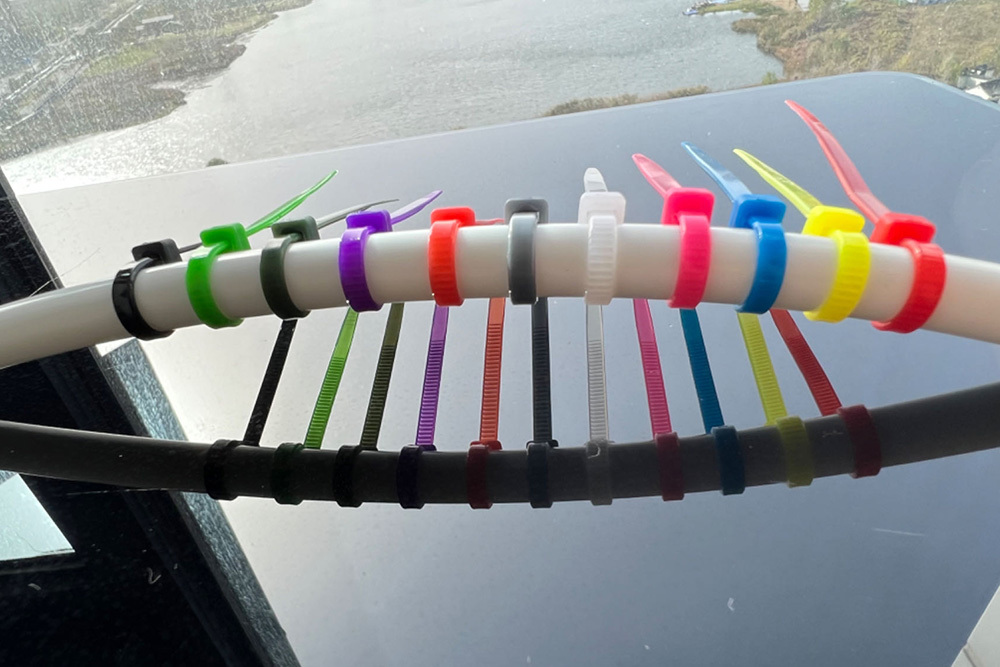08
2025
-
08
Plastic cable ties and cable classification binding
Author:
Organizing Cables with Plastic Zip Ties: A Structured Approach to Classification and Binding
Managing tangled cables in workspaces, home offices, or entertainment centers can be both inefficient and visually unappealing. Using plastic zip ties for cable organization offers a durable, low-cost solution to keep wires neatly grouped and accessible. Below is a detailed guide to help you classify and bind cables effectively while maintaining flexibility for future adjustments.
Identifying Cable Types and Grouping Requirements
Before securing cables, assess the types of wires you’re working with. Categorize them by function, such as power cords, data transmission lines (e.g., HDMI, USB), or audio/video connections. This separation prevents interference between high-voltage and low-voltage cables, which is critical for safety and performance. For example, keep power adapters and extension cords in one group, while separating network cables or peripheral connections into another.
Considering Cable Length and Flexibility
Group cables with similar lengths to avoid uneven bundles that may sag or twist. If some wires need to reach different devices, create subsets within larger bundles using shorter zip ties. For instance, bundle monitor cables together but leave slack near the ports to allow for screen adjustments. This approach ensures cables remain functional without compromising organization.
Selecting the Right Zip Tie Size and Placement
Choose zip ties based on the diameter of your cable bundles. Thicker groups require wider ties, while smaller clusters can use narrower options. Start binding cables at one end, leaving a 1–2-inch gap to accommodate slight movements or repositioning. Position the zip tie perpendicular to the cables to distribute pressure evenly and prevent crimping.
Spacing Zip Ties for Stability
For longer cable runs, add additional zip ties every 6–12 inches to maintain structure. Avoid over-tightening, as this can damage cable insulation or restrict airflow around heat-generating devices. If cables branch off, use smaller ties to secure subsets separately while keeping them connected to the main bundle. This method ensures stability without sacrificing accessibility.
Labeling Bundles for Easy Identification
To streamline future maintenance, label each cable group clearly. Use adhesive tags or permanent markers to note the purpose of each bundle, such as “Printer Cables” or “Router Connections.” Place labels where they’re visible without obstructing cable paths. This step reduces the time spent tracing wires during troubleshooting or equipment upgrades.
Using Color-Coded Systems (Optional)
If working with multiple categories, consider assigning colors to different types of cables. For example, use white ties for power cords and black ties for data lines. While not necessary, this visual system can enhance organization in complex setups. Ensure consistency across all bundles to avoid confusion.
Maintaining and Adjusting Cable Groups Over Time
Periodically inspect zip ties for signs of wear, such as cracking or loosening. Replace damaged ties immediately to prevent cables from slipping out of place. If you add new devices, integrate their cables into existing bundles or create separate groups using the same classification method. Avoid overloading zip ties with excessive cables, as this can weaken their grip and lead to disorganization.
Allowing Room for Future Changes
When binding cables, leave slight flexibility to accommodate new connections or reconfigurations. For example, avoid securing cables too close to plugs or sockets, as this may limit access. Use removable zip ties if frequent adjustments are expected, or plan for additional slack in static setups. This foresight ensures your organized system remains functional as needs evolve.
By following these steps, you can transform chaotic cable networks into structured, easy-to-manage systems. Proper classification and binding not only improve aesthetics but also enhance safety and efficiency in any workspace.
plastic cable ties
Hot News
2025-08-08
Plastic cable ties and cable classification binding
Managing tangled cables in workspaces, home offices, or entertainment centers can be both inefficient and visually unappealing. Using plastic zip ties for cable organization offers a durable, low-cost solution to keep wires neatly grouped and accessible. Below is a detailed guide to help you classify and bind cables effectively while maintaining flexibility for future adjustments.
2025-08-08
Steps for organizing plastic cable ties and wires
Managing tangled wires and cables can be frustrating, but plastic zip ties offer a simple, cost-effective solution. Whether you’re tidying up a workspace, entertainment center, or home office, following a structured approach ensures a clean and functional setup. Below is a detailed guide to help you streamline the process.
2025-08-07
Plastic cable ties for interior decoration binding
Indoor decor projects often require creative solutions for bundling, securing, or organizing items without compromising style. Plastic cable ties, when used thoughtfully, can serve as versatile tools for everything from managing electrical cords to crafting decorative displays. Their strength, affordability, and ease of use make them ideal for DIY enthusiasts and professional decorators alike, provided they are applied in ways that align with aesthetic goals and structural needs.
2025-08-07
Plastic cable ties for outdoor use protection
Outdoor applications, ranging from construction projects and landscaping to vehicle maintenance and agricultural setups, expose plastic cable ties to harsh conditions that can degrade their performance over time. Factors like ultraviolet (UV) radiation, temperature fluctuations, moisture, and physical abrasion can weaken ties, leading to premature failure. Implementing targeted protection measures ensures their reliability and extends their lifespan in outdoor settings.

